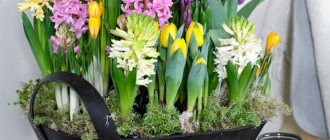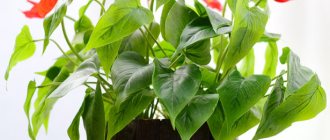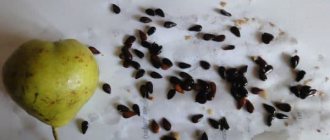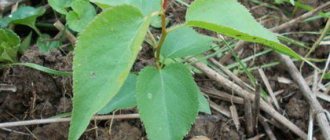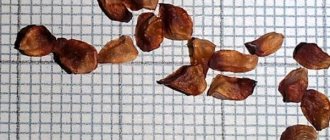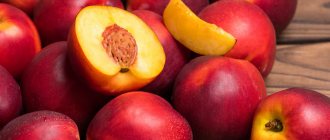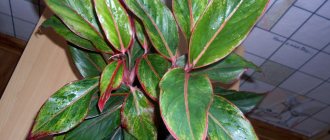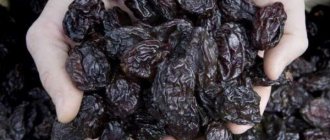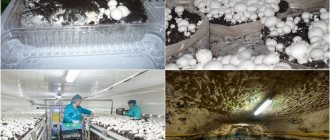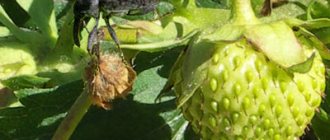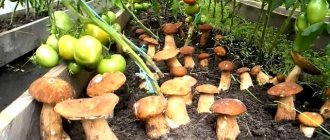Planting seeds
You can germinate seedlings either in a garden bed or in some container. The soil in which the seeds will be sown is best prepared from approximately equal parts of turf, peat and sand. It is also necessary to ensure the sowing site has good drainage.
The seeds are sown in the furrows quite densely (at the rate of 150-200 seeds per square meter) and shallowly. The depth of the seed should not exceed 1.5-2 centimeters, otherwise the seedlings will not sprout.
The most suitable time for planting is the beginning of autumn, while seedlings will appear only next spring. Planted seeds must go through a period of vernalization, so it is better to store the container in a cool place in winter, sometimes moistening it moderately. If planting is done in an open area, then the bed is covered for the winter with a 20-centimeter layer of compost, hay or similar mulch.
On a note! Hyacinth seeds ripen in capsules that form when the flowers fade.
To prepare them, select light yellow, unopened boxes, dry them for several days and collect the dry seeds in paper bags. Before sowing, store in a cool, dry place. The first shoots that appear after 5-6 months are not touched, because the plants are very weak and not rooted. They only need to provide:
- Periodic weeding
- Regular moderate watering
- Loosening the top layer of soil
- Protection from mechanical damage
- Sufficient but not direct sunlight
- Fertilizing (you can use superphosphates, ammonium nitrate)
The first year the weak bulb is not dug up, leaving it to overwinter in the ground. Starting next year, like all bulbous plants, they are dug up in the summer, dried well in a dark, dry room and stored until autumn. In autumn, the bulbs are planted in the ground. If seeds are grown in seedling containers, they are not replanted for two years after sowing.
The optimal place for them is cold greenhouses.
Rules for planting hyacinth in autumn
Term
Planting hyacinths in the fall: when and how to plant seeds correctly? Experienced gardeners recommend doing this in early September. We are talking about central Russia. Approximately, the seed is planted in the ground 20-30 days before planting the bulbs. Seeds need more time to develop.
Soil and place
The bed is prepared in the same way as for bulbs, a month before planting. The soil is well dug up. Peat, humus, and river sand are added. The seeds will take root in loose, breathable, fertile soil. Complex mineral fertilizers are also applied.
The place for the crop is selected without drafts, light, but not completely open, so that the sun's rays do not burn the plant. If the garden is large, then choosing a place will not be difficult.
Step by step guide
- Before planting, the bed is moistened.
- Trenches are made in it, about 1-2 cm deep.
- Hyacinth seeds are sown in the depressions. Due to the fact that they are small, they are not planted too rarely.
- The planting scheme implies a distance between rows (trenches) of about 10-15 cm. It is allowed to sow 250 pieces of seed per square meter.
- If you plan to grow an indoor flower, then the seed is placed in containers with soil mixture. These containers are then stored underground or in the refrigerator. Thus, the conditions become close to natural.
Additional Information. The gardener chooses the day to plant hyacinths. The most optimal time would be a quiet autumn afternoon without wind, bright sun or rain.
Further care of seedlings
Bulbs obtained from seeds are a planting material already familiar to everyone and are handled normally. As you know, hyacinths are planted in the soil in the fall, covered with a thick layer of straw or similar material.
Before planting, the bulbs can be treated with a fungicide; after all, hyacinths are a little capricious and susceptible to diseases. In the spring, after germination, the flowers must be fed.
It should be remembered that plants grown from seeds bloom only after 4-6 years - this is a long-term method that requires time and patience.
But the resulting hyacinths, as a rule, do not inherit maternal characteristics, that is, it is quite possible to obtain a completely new, unusual variety of flower. This is what attracts breeders and enthusiastic gardeners to seed propagation. If it is possible to grow a truly new type of exquisite flower, then in the future it is propagated using the usual, bulbous method.
With proper propagation, hyacinth will be a sight to behold!
Hyacinth is one of the most beautiful garden plants that delights with flowering in early spring. Their lush curly caps of delicate shades will decorate any flower bed. Gardeners who have many varieties of this beautiful primrose on their plots have mastered the intricacies of hyacinth propagation.
There are three such methods - seeds, part of a leaf and bulbs. Each of them has its pros and cons, and for successful breeding you need to know how to propagate hyacinth at home with any of them.
Hyacinth flowers - planting and care
It cannot be said that growing hyacinths in open ground differs significantly from caring for them at home. But each option has its own secrets and subtleties. In order to achieve flowering of a plant at a time when this a priori should not happen, it is necessary to understand the nature of this flower and the process of forcing. Forcing is a set of measures taken to accelerate the growth of a plant. Using this process, you can achieve hyacinths blooming for a specific holiday or date.
Mouse hyacinth - a slender and interesting flower
This flower reproduces by bulbs. A healthy bulb should be dense, its diameter should be 5 cm, and its weight should be at least 80 grams.
How to propagate hyacinth from a bulb
Like any corm plant, in nature hyacinth reproduces by bulbs that form next to the mother bulb. Each of them forms only one child. This happens when an adult plant has gained enough vegetative mass and strength to begin the division process.
The baby is formed from one of the covering scales, which begins to grow rapidly and gradually separates from the main tuber. All this time, the plant does not bloom, but devotes all its energy to the formation of a daughter bulb. The separated young hyacinth bulb grows its above-ground part for several years and blooms only in the fifth or sixth year.
Biologists were not satisfied with such a slow breeding process, and they looked at how a plant behaves when it is attacked by pests and dies. It begins to intensively grow children, trying to leave offspring before the death of the mother's bulb. As an experiment, scientists tried to carefully cut out its lower part along with the embryo of a flower bud, simulating a quick death. The trick was a success, and the plants began to form numerous children, which were enough for further breeding.
The method turned out to be so successful that it is currently used for the industrial production of a large number of new plants, which are then sold or used in landscaping parks and local areas.
Bulb planting time
You bought a hyacinth bulb in the flower department, and now you are faced with the question of when to plant it. In Russia, the conditions for autumn planting of onions in open ground are similar to the agricultural technology of winter garlic. In the middle zone, the dates begin at the end of September and the first half of October, and in the southern zones you can plant throughout October.
The time must be selected so that before the onset of stable frosts, the onions take root, but do not send out leaves. Planting too early or too late leads to the fact that the unrooted or growing bulb freezes and rots.
How to sprout hyacinths from a bulb at home
As a rule, at home, bulbs are germinated for early forcing. To get a flowering bush at the right time, you need to know the plant variety. The table shows when to plant hyacinth bulbs of each flowering period:
| Flower variety | Flowering time | Landing dates |
| Early | December - January | Second half of October |
| Average | February-early March | The beginning of November |
| Late | Early to mid April | End of December |
Important! For growing hyacinth in a pot, only the largest bulbs with a diameter of at least 5 cm are suitable. For successful flowering, they must go through a full dormant period or be purchased labeled “For forcing.”
The pot should be of such a size that the bulbs do not touch each other or the edge of the pot. A drainage layer is placed at the bottom and a soil substrate is prepared with the following composition:
- 0.5 parts of river sand;
- 2 parts of turf or leaf soil;
- 1 part mature compost or humus.
Forcing hyacinths
Brugmansia planting and care in open ground, as well as propagation at home
If you are using plants from your own garden, then in the spring, look at which of them will produce the largest flower stalks, and from those you will need to take the bulbs. But you can’t let the peduncle bloom; cut it off. Then the plant will give all its unused strength to the bulb; it will contain enough nutrients to push out the peduncle at the scheduled time and delight you with an amazing sight.
If you are planning to force hyacinths for the New Year and at a later date, then do not dig the bulbs out of the ground until the end of July. If you want to see the buds bloom earlier, then you need to remove the planting material from the soil in early or mid-July. By this time, the leaves will wither and the hyacinth bulbs will have time to ripen well.
Please note that they must be healthy, dense, without signs of damage or infection. Large and medium-sized bulbs with a diameter of at least 5 cm are suitable
First, they need to be dried at a temperature of +20–+25°C for at least three weeks, and then immersed in a state of artificial rest, placing them in a cool place.
Vegetable drawers in the refrigerator or cellar, where there is no high humidity, are suitable for this. Planting material should be kept at a temperature of +2–+9°C for 3 months. Therefore, calculate the desired flowering time, subtract 3 months from them, as well as the time for rooting of the hyacinth and extension of the peduncle (3–4 weeks).
After you remove the plant from the place where it was chilling, plant it in a loose, moist substrate so that the top of the bulb is above the soil level. At the same time, she does not need a spacious pot; a small one, the diameter of which is 2–3 cm larger than the diameter of the bulb, will do.
You can plant the bulb directly in the soil and cool it in it at + 5–+ 8 ° C, putting it in a dark room for 10–12 weeks or covering it with an inverted pot. After this, place it on the windowsill, but gradually accustom it to light and first avoid direct sunlight. Flowering will occur in 3-4 weeks.
You can achieve hyacinth flowering not only in the ground, but also in water. To do this, you will need a container shaped like an hourglass. Pour water into its lower part, and place the onion (previously cooled for 3 months) into the upper part. Its bottom should not reach the water level by 5 mm.
How to grow hyacinths from seeds
This method is most often used to experiment with breeding new varieties. Hyacinth seeds look unique - black pubescent balls with white tails, and the size is easy to estimate from the photo. They are collected when the boxes begin to turn yellow, but have not yet opened.
The soil mixture for germinating hyacinth from seeds is prepared in the same way as for bulbs. The seeds are sown quite densely - 150-200 pieces per square meter and planted no deeper than 2 cm. The best time for sowing hyacinth seeds is early autumn, about a month before planting the bulbs. For the winter, the bed is covered with spruce branches, hay or compost from frost.
Hyacinth seeds sown at home must go through a period of vernalization. To do this, after planting, they are kept on the top shelf of the refrigerator. At the end of winter, the seedling containers are moved to a cool windowsill.
Shoots appear in spring. The seedlings are weak, grow slowly, and the root system is poorly developed. Therefore, they are not replanted and all care activities are carried out very carefully. In the first year, sprouts need:
- regular weeding;
- moderate watering with settled water;
- careful loosening of the top layer of soil;
- diffused sunlight;
- fertilizing with complex mineral fertilizers.
To create a gentle microclimate and protect against damage, cover the bed with seedlings with any agricultural fabric, leaving holes for ventilation. Young plants bloom at 5–6 years.
How to grow a flower at home?
You can grow a flower at home both in winter, right in the refrigerator, and in mid-autumn in a pot on a windowsill or in the open ground. Main growing methods:
- onion in a pot;
- seeds in open ground or pot;
- onion in water.
The process of forcing a peduncle takes about 3-4 months, but preparation for flowering should begin in advance, in the summer. Let's look at each growing method separately.
In winter in the water
In order to grow hyacinth bulbs in water in winter, you will need a suitable container, for example, a deep vase, but always with a narrow neck. Such a vessel is needed so that the hyacinth bulb can be placed above the water level (otherwise it will rot), but so that its roots are completely immersed in the liquid. If you don’t have the required container, it’s okay, you can take an ordinary mug and cut a circle out of cardboard, cutting a hole in it for the roots of the onion. Then fill the container with water, cover with the prepared cardboard lid and place the hyacinth. Be sure to ensure that the roots are completely submerged in water.
When everything is ready, you can put the mug or vase in the refrigerator. If you want to receive flowers by the beginning of spring, then you need to carry out preparatory work in early November.
Note: To keep the water in the container fresh for a long time, you need to add a little activated carbon.
Check the amount of liquid periodically and replenish the container with fresh water as necessary. Be sure to return the structure to the refrigerator until the first sprout appears. When the sprout stretches upward by about 4-5 centimeters, you can move the improvised vase into the room on the coldest windowsill in the house. Then the plant can be grown like an ordinary flower in a pot.
After this type of flower forcing, the bulb will be unsuitable for repeated use, as it will be completely depleted. » alt=»»>
Hyacinth from bulb
To grow hyacinth from a bulb in a pot in an apartment, you need:
- Prepare the plant bulbs in advance. You can dig it from your own garden, if you have one, when all the leaves have completely dried out or fallen off (usually from June to July), or purchased from any flower shop in late summer or early autumn. The bulbs need to be large and dense, about 5 centimeters in diameter. When purchasing bulbs in the fall, you need to pay attention to the mark “for forcing”, since these flowers have gone through a period of complete dormancy and were stored at low temperatures, and therefore are now able to bloom well. Before planting flowers, the bulbs must be stored in a dark, cool and always dry place (with a temperature no higher than 17 degrees).
- Choosing a pot. The size of the container should be chosen based on the number of bulbs that you plan to plant (the more bulbs, the wider the pot). The height of the pot must be at least 15 centimeters, otherwise the roots will have nowhere to grow.
- Soil preparation. It is necessary to place drainage at the bottom of the container; this is done in order to avoid stagnation of water after watering. Purchased or homemade - decide for yourself, the main thing is that it is pebbles, coarse sand or shards.
- Landing. Take soil, preferably purchased from a flower shop, or universal soil. Pour a couple of centimeters of soil and sprinkle a centimeter of coarse sand on top. Tamp down lightly, water generously and place the bulbs in the soil. If you are planting more than one, be sure to space the bulbs. Sprinkle loose soil on top, but so that the top of the onion remains uncovered (cover about two-thirds of the onion). No need to water again.
- The pot should be placed in a cool, dark place for about two or three months (temperature no more than 6 degrees Celsius). You need to hide the workpiece so that the onion takes root. The most suitable place is the bottom shelf of the refrigerator, designed for storing vegetables and fruits. Most likely, you will not need to moisten the soil, but if you notice that it is dry, then water a little, but do not get water on the bulbs.
- After the specified time, the first shoots should appear. As soon as the length of the sprouts reaches 4 or 6 centimeters, the pot can be placed on a cold windowsill (no more than 13 degrees Celsius).
- For the first couple of weeks, growing flowers must be kept in the shade, so it is recommended to make a cap out of thick paper and cover the pot. Otherwise, the leaves may turn yellow from exposure to the sun. After a month, if the pot is positioned correctly, the sprout should stretch up to 15 centimeters.
- Watering. The soil in the pot should not dry out under any circumstances, so do not forget to systematically water the soil, but not too much, so as not to flood the flower.
- Lighting. As soon as the leaves begin to open and the peduncle is ready to bloom, you need to move the pot to a well-lit place, but without direct sunlight on the sprout, and also away from radiators or heaters.
- Temperature. The room should be approximately 20 degrees Celsius and should be regularly ventilated, but avoid drafts.
The best time to plant bulbs is in early November, then you will get beautiful flowers by spring.
Note: When storing the pot in the refrigerator, never cover the container with a plastic bag, otherwise the bulbs will rot.
Grow from seeds
It is possible to grow hyacinth from seeds, regardless of the fact that the plant is a bulbous one. Usually they resort to this type of planting to experiment with breeding a new variety of flower or because they do not want to bother with bulbs. You can plant seeds either at home in a pot or in the open ground in the garden, the principle is identical. But first, the seeds must be prepared for ripening:
- Soil selection. The best soil is peat mixed with coarse sand and turf in equal proportions. You also need to purchase drainage.
- Sowing. Seeds should be scattered generously over the prepared soil, approximately 150-200 seeds per square meter of land. The seeds do not need to be planted deeply; it is enough to make indentations from one and a half to two centimeters deep. Otherwise, the seeds will not germinate.
It is best to plant in early autumn, just as with bulbs. In winter, if you are doing seedlings at home, the seeds in the container should be hidden on the bottom shelf of the refrigerator, and if outside, then for the winter you need to cover the seeding area with thick compost, cover it with hay or something similar.
After the first flowering, the bulbs are not dug out of the ground, as they are too weak. After the next season, such bulbs can be dug up along with everyone else in the summer. Bulbs that have been grown from seed in a container or box are not replanted for the first couple of years.
Propagation of hyacinths by leaves
This interesting method is another option for obtaining new flowers. It consists in the following. At the beginning of flowering, one or two leaves are cut from the plant, cutting them off with a knife at the base. The leaves are cut crosswise into pieces 6–7 cm long. The upper part is thrown away. Then the lower sections are dusted with root-forming powder or dipped in its solution and planted in wet, washed sand. The planting container should be low and wide. Leaf cuttings are dropped in at an angle, the top of the container is covered with film and placed in a cool, illuminated place.
Bulbs at the ends of the cuttings appear about a month after planting. When they increase in size and send out their own roots, they are planted in light nutritious soil. Further care of the seedlings is the same as with other methods of propagation. When the bulbs reach 3 cm in diameter, they are considered mature.
Hyacinths: propagation by bulbs
This propagation method is the most popular among gardeners. Because at the lowest costs it allows you to obtain a large amount of planting material.
Propagation of hyacinths by children
Hyacinth babies are formed under natural growing conditions annually, in the amount of 3-4 pieces on one mother bulb. The children separate from the main bulb during the summer dormant period. When the baby is ripe, it just needs to be separated from the main bulb. And that’s all: after a period of dormancy, a small bulb can be used as planting material. With this method of growing, the hyacinth will bloom within 2-3 years from the moment the baby is separated and planted in the ground.
Growing hyacinths in pots
How to grow hyacinths in pots?
The plant prefers bright, diffused light. Does not like cold winds and drafts.
The soil should be loose and breathable. Humus must be added to the substrate.
The containers must have a drainage system that will not allow excess moisture to accumulate. Expanded clay, pebbles, shards or broken bricks are suitable for this.
After flowering, the peduncle must be cut off. At the beginning of autumn, watering and fertilizing are reduced to a minimum.
At the beginning of winter, the plant enters a dormant period. At this time, the leaves shrink and die. All useful substances pass into the onion.
Lighting
Hyacinth in a pot, just like hyacinth in the garden, loves sunlight, but not the burning rays of the sun. If the duration of the daylight period is 12-15 hours a day, then the plant will delight others with its beauty. Moreover, it does not matter at all whether it is artificial or natural lighting.
If you create the right lighting, the plant will delight others with its beauty for a long time.
Reproduction
Let's look at how to propagate hyacinths at home. There are four methods of reproduction.
Seeds
Propagation of hyacinths at home using seeds should only be used for breeding new subspecies.
When planted with seeds, the plant will bloom only 6-9 years after planting.
How to grow hyacinth from seeds at home? It is best to start planting material in warm weather. It is necessary to select boxes that have not yet opened.
It is important that they are amber in color.
It is not recommended to use emerald ones, as they have not yet had time to ripen. A week after assembly, the boxes crack on their own.
The seeds are thoroughly dried and cleared of scales. It is best to use paper bags. Before sowing, they must be stored in a cool room.
It is necessary to prepare containers with the substrate. Make small grooves no more than 2 cm deep.
If you sow seeds deeper, they will not have time to sprout and will rot in the soil.
For 1 sq. about 200 seeds are sown per meter. Drainage and sand must be poured into the bottom of the container. This will prevent the root system from rotting. In six months you should expect the first shoots.
By the end of the growing season, a small onion should appear. It has a pear shape. During the entire growing period, the soil must be loosened, fertilized, ventilated, and systematically watered.
Bulbs
How to grow hyacinth from a bulb?
For each bulb, allocate one container with a diameter of 18-20 cm. Drainage is made into the container from clay petioles. Fine-grained sea sand is poured onto the bottom.
The soil should be fortified with plenty of nutrients.
The bulbs are planted in such a way that 1/3 remains on the soil surface. The depth of embedding should not exceed 4 cm. The soil must be loosened, fertilized and systematically watered.
Two years after planting, a full-fledged plant should grow. At the 3rd or 4th year of life, this representative of the flora begins to bloom. During all active growth, the flower requires a temperature of 17-21°C. The room should be bright and well ventilated.
Leaflets
In the budding phase, this representative of the flora can be propagated by leaves.
You can take 2 leaves from each flower. They are immediately dipped into the heteroauxin mixture. Half the tablet is diluted in 1 liter of water.
It is necessary to keep the leaves in the solution for 6-9 hours.
Then they are planted in containers with substrate. The soil is mixed with fine-grained sea sand and peat.
After 9-11 days, callus should appear on the wound surface. After a month, the first rudiments of the bulbs appear. After 60 days, the bulbs should have young new leaves and a root system. After this, the flower must be transplanted into nutritious fortified soil.
One leaf can produce from 7 to 10 babies.
Double scales
The bulbs are cleaned and dried. The onion must be cut off 1/3 of its height. After this, it is divided into 8 equal parts.
It is important that each part retains a small piece of the bottom.
One large bulb can produce up to one hundred paired scales. To disinfect wounds of planting material, it is necessary to use crushed charcoal.
Then the planting material is placed in plastic bags with perlite. Perlite is pre-moistened with 1 drop of foundationazole mixture. The packages are tied tightly.
After 30 days, callus should appear on the cutting line of the scales. It forms tubercles - new embryos of future bulbs. They must again be treated with foundationazole and placed in plastic bags.
3-4 months after division, the planting material should form a root system. Then each bulb is planted in a substrate of fine-grained sea sand. The containers are placed in a cold room.
The substrate must be kept moist at all times. Periodically it is necessary to wait for the top layer of soil to dry out. You can find out more about planting hyacinth indoors here, and we talked in more detail about planting hyacinths in open ground in this material.
Home propagation methods
Every bulbous plant is propagated by children, they are separated from the mother plant, planted in a flower bed or in pots, and grown according to basic needs.
It’s clear what to do with the baby hyacinths. The question is: how to get them. There are several ways to propagate hyacinth at home. New flowers can be grown from seeds, leaf cuttings, or many children can be obtained at once by performing certain manipulations with the tuber. The latter method is distinguished by the possibility of producing a large number of children at once, which is suitable not only for home breeding, but even for industrial breeding.
Manipulations with the bottom of the tuber
The propagation of hyacinths by bulbs was suggested by pests. Attentive gardeners have noticed that on a bulb damaged by rodents, a large number of children are formed at once.
To achieve the appearance of babies at home, take the onion at rest, wash it, free it from the remains of leaves and dried scales, then carefully scrape out the bottom, make a funnel-shaped hole, removing the central bud
Another method differs in that a cross-shaped cut is made on the bottom until thickening begins (approximately a third of the length of the tuber). If the onion is large, then there may be several cuts to divide the area of the bottom into 6 parts rather than 4.
Damaged areas must be generously sprinkled (or even coated) with fungicide or activated carbon to avoid infection with diseases. After these manipulations, the bulbs are placed in pots with the bottom up, covered with glass or a bag to create a greenhouse effect.
You can place vermiculite or sphagnum moss on the bottom of the dish, which retains moisture well. Some gardeners place the tubers bottom down in vermiculite or sand. Humidity (85-90%) will help to germinate the babies. They will appear in 1.5-5 months.
A special temperature regime will help speed up the process: for the first couple of weeks the temperature should be high - about +30 °C (a heating pad or baby bottle warmer will help), and then for another 2-3 weeks it is lowered to +17...+20 °C.
You can grow babies on scales. To do this, the onion is cut into 4 parts, the living scales are removed from the bottom edge, placed in vermiculite or sand under the same conditions (heat and moisture). Only all the scales are separately packaged in plastic bags, occasionally opened to check, moisten and treat with fungicide.
The bulbs (or scales) with the emerging children are placed in pots with loose soil until spring and removed to a place where the temperature does not rise above +5 °C. In the spring, they are planted in open ground, and during the dormant period they are put back in the basement to avoid freezing. This needs to be done for several years in a row, then the children will grow up, get stronger, and they can be separated from the mother tuber. A new plant will bloom in 4-5 years.
Leaf
As soon as the plant forms a peduncle, you can take a couple of leaves from it, tearing them off carefully at the very base. The leaves are treated with a substance to accelerate root formation, buried 3-4 cm in damp perlite or sand at the bottom of the bag, placed in a bright place
For 1.5-2 months, you need to maintain a humidity of 90% and a temperature of +10...+17 °C. During this time, 5-10 babies should appear at the base of each leaf.
At first they will look like small lumps, then they will develop into babies with roots and even new leaves. In spring they are planted in the garden. For the winter, it is better to remove young plants from open ground, but if the winter is not very frosty, you can simply mulch the plantings thoroughly.
Seeds
Hyacinth grows from seeds to flowering in 5-7 years
When the boxes begin to turn yellow in the warm sunny summer, they are cut off, laid out until completely dry, then they open, the seeds are carefully collected, sorted into bags in accordance with the variety and color.
The speed of their germination depends on when to plant hyacinth seeds. If you sow them in the fall, while the earth is still warmed by the sun, then seedlings will appear in the spring. After sowing in spring, the seeds germinate only the following spring.
The easiest way to germinate seeds is to sow them in a greenhouse on sand, where it is easier to regulate heat and humidity.
You can stimulate the education of children in different ways or get ripe seeds of the hyacinth you like. The key is to be patient while the new plants reach flowering age.
How to grow Hyacinth from seeds at home
How to grow Hyacinth from seeds at home
Hyacinth is a perennial bulbous plant of the lily family. The flower's homeland is Asia, although currently most of the plants are grown in Holland, which supplies planting material to all countries.
The plant is 20-60 cm high and has straight narrow leaves, 5-8 pieces each, located at the base of the stem. The flowers are small, exuding a delicate aroma, shaped like a bell, collected in a spike-shaped inflorescence of 15-45 pieces, tightly adjacent to each other.
Flowers can have the following colors:
- blue;
- purple;
- white;
- pink;
- yellow;
- creamy.
Hyacinths are propagated by seeds and bulbs.
Growing hyacinth in open ground
Hyacinths are most often propagated by planting bulbs. Depending on the variety, the bulbs have different sizes. Bulbs of terry varieties are always smaller in size than usual. Planting material must meet the following requirements:
- the diameter of the bulb must be at least 4 cm, have a healthy growth bud and a large number of scales;
- the bulb should be elastic and heavy;
- there should be no damage or mold;
- in the lower part there must be root buds;
- the volume of the bottom should be half the volume of the onion.
Having chosen high-quality planting material, you need to take care of choosing a place for planting. The site should be located in a well-lit place, protected from the wind. The bed is pre-prepared, humus or peat is added. It is not recommended to use manure as fertilizer. If the soil acidity is high, it is recommended to add dolomite flour. Plants do not like stagnant moisture, so care must be taken to have a drainage layer.
Planting is carried out from the second half of September to mid-October. The soil temperature during planting should be at least 10 degrees. The bulbs are planted at intervals of 12-15 cm, leaving 20 cm between rows.
Hyacinth in the garden from a bulb
In order to grow hyacinth in the garden from a bulb, you must follow the following recommendations:
- You need to choose medium-sized bulbs; it is better to save the largest ones directly for forcing. The bulb must be dense, without any visible damage or pest-infested areas. If the onion is soft, then it’s better to throw it away immediately and don’t waste time, it won’t sprout anyway.
- Choose a suitable time for planting, usually during Indian summer (late September or early October).
- Place. To plant bulbs in the garden, you need to choose a well-lit, open area where there are no strong winds. The selected area should be located away from trees or shrubs, otherwise their roots will take all the moisture. It is best to choose a plot of land that is flat or has a slight slope so that water drains and does not linger in any niches.
- The soil. The soil must be dug up in advance and fertilized. Mineral fertilizers or humus are suitable for this purpose, but under no circumstances use fresh manure. A flower will not be able to bloom in soil with acidic and dense soil in which water stagnates. Therefore, if you have any of the problems listed above, it needs to be fixed. For example, lay drainage or add sand, you can also use lime.
Video: how to plant hyacinth in open ground
After the bulbs are planted, the bed must be covered with spruce branches, sawdust or covering material to retain heat. With the arrival of spring, the covering material is removed from the garden bed.
Further care for hyacinths consists of the following activities:
- Regular watering.
- Loosening the soil;
- Weed removal;
- Feeding. After the sprouts appear, it is recommended to add ammonium nitrate at the rate of 25 grams per 1 square meter. meter. During the period of bud formation, add per 1 square meter. meter:
- potassium chloride—25 grams;
- ammonium nitrate - 25 grams;
- superphosphate—35 grams.
After the completion of the flowering period for 1 sq. meter should be entered:
- potassium chloride—35 grams;
- superphosphate—35 grams.
- After the flowers dry, watering must be continued to saturate the roots with moisture and restore the bulbs after flowering.
- After flowering ends, the bulb is dug up, dried and stored in a cool room until the next planting.
Diseases
The popularity of hyacinth lies in its resistance to disease. But sometimes the plant gets sick.
How to determine the disease and its causes:
- Most often, hyacinth is affected by yellow bacterial rot. An unpleasant odor begins to emanate from the bulb and it becomes slippery. Unfortunately, this is the death of the plant. You need to get rid of this flower.
- If the peduncles become bent and the flower begins to grow poorly, it means that it is being attacked by pests. In this case, the plant will be helped by preparations containing phosphorus.
- Sometimes a young inflorescence may fall out of the common flower. Improper care of hyacinth at home is the main cause of this disease. The cause may be improper storage of bulbs or increased soil moisture.
Water hyacinth is a beautiful plant with soft purple flowers.
Advice! If the bulb was purchased in a store, then before planting, to prevent infection, it must be kept for 15 minutes in a solution that contains phosphorus.
Replanting hyacinth after flowering at home
After the flowering period has ended, it is necessary to remove the peduncle and move the bulb to a larger pot. After drying, remove the bulb from the pot and store until autumn.
For replanting, it is necessary to prepare nutrient soil by mixing the following ingredients in equal proportions:
- sheet soil;
- turf soil;
- compost;
- humus;
- sand.
Complex mineral fertilizer is added to this mixture.
Place a layer of small pebbles at the bottom of the planting container, then add prepared soil. Bury the bulbs 2/3, positioning them so that they do not come into contact with the walls of the pot. The neck of the bulb must be left on the surface to avoid rotting.
Watering should be done with extreme caution so that water does not get on the bulb. After flowering ends, the dry stem is removed and watering is carried out to keep the soil moist until the leaves turn yellow. After the leaves wither, watering is stopped and after 14 days the bulb is removed from the ground. Then it is dried for a week in a well-ventilated room at a temperature of +20 degrees.
After drying, it is necessary to separate the children and remove dead scales. After this, a rest period begins, lasting 90 days. It is better to store the bulb in a cool room, gradually lowering the temperature.
For the first 56 days, the storage temperature should be +25-26 degrees. For the next 28 days, the temperature should not exceed +17 degrees. Two days before planting, the temperature is reduced to +5 degrees.
How to care for hyacinth
Hyacinth cannot grow at home for several years. The bulb is forced once. At this time, it loses a lot of strength and it is unlikely that it will be possible to achieve excellent flowering again. After forcing, the bulb can be planted in the garden.
Watering and fertilizing
Hyacinth is a moisture-loving flower. The plant must be watered regularly, after the top layer of soil has dried. In this case, it is recommended to pour water only along the edge of the container, since liquid getting into the axils of the leaf blades can cause the death of the hyacinth. The procedure requires soft, settled water at room temperature. Ideally, it will be rain or melt. The flower does not need additional moisture in the form of spraying.
When forcing hyacinth in water, it is necessary to periodically add it to the vessel. Experienced gardeners recommend adding not water, but a weak solution of complex fertilizer. For feeding, you can use a universal preparation for bulbous plants, diluting the solution at half the dose recommended by the manufacturer.
Hyacinths grown in soil mixture also respond well to fertilizing. The color of the flowers becomes brighter, and the flowering period lasts much longer. As a fertilizer, it is recommended to use universal preparations for bulbous or flowering plants. The procedure should be carried out once a week from the moment the leaves appear until the plant fades. After this, feeding should be stopped completely.
Feeding hyacinths makes flowers brighter
Features of caring for the plant after flowering
After the hyacinth flowers wither, the peduncle should be trimmed. During this period, you should completely stop feeding, but continue to water the flower until the leaf blades turn yellow. During this period, the number and volume of watering must be reduced by approximately half. There is no need to cut off yellowed leaves; they should die off naturally.
How to provide hyacinth with a dormant period
When the leaf blades wilt, remove the bulb from the pot. Dry it for five to seven days in a well-ventilated place at a temperature of about 20–22°C. After this, remove all dead scales and trim the roots. Provide the hyacinth bulb with a period of “sleep”, which should last approximately 3 months. During forcing, the bulb is greatly depleted and cannot be subjected to the procedure again. The plant can be planted in the garden in August and enjoy its flowering for several more seasons.
Table: consequences of improper care and what to do to solve problems
| Problem | Probable Cause | How to fix the situation |
| Flowering does not occur | Very high temperature | Move the flower to a cool place and cover it with a cap made of thick paper. |
| Flowers rot and fall off | Severe waterlogging | Adjust the watering regime, moisten only after the top layer of soil in the pot has dried. Water along the edge of the container, being careful not to get water on the flower. |
| The buds are falling | Water getting on the buds | Do not spray the plant, especially during flowering. |
| Leaf blades turn yellow | Draft | The flower does not tolerate sudden changes in temperature and drafts, so move the plant to another place. |
Replanting a plant after purchase
After purchasing a plant from a flower shop, it is recommended to replant it, since the flower is sold in a small pot and there is not enough space for it, moisture and not enough nutrients. After purchase, the flower is left for 14 days to adapt to the new microclimate. The faded flower is transplanted into a larger pot, deepening the bulb 2/3. The gap between the walls of the pot and the bulb should be no more than 1 cm. After transplantation, the plant is placed in a cool room. Lighting should be moderate. Watering is carried out as needed through a tray.
Fertilizing is carried out 14 days after transplantation. To do this, use complex mineral fertilizers, reducing the dosage by half from that recommended in the instructions.
